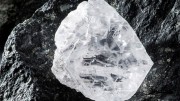Jean-Marc Lieberherr readily concedes that the industry he represents and speaks for – global diamond mining – has an image problem. “There are so many misconceptions about diamond mining,” says Lieberherr, chief executive officer of the Belgium-based Diamond Producers Association. “Issues from the 1990s, like conflict diamonds that funded several African civil wars, are real scars in the history of the industry.”
Much has changed within the industry over the past 20 years. In 2003, the United Nations General Assembly passed a resolution establishing the Kimberley Process Certification Scheme, which aimed at preventing conflict diamonds from entering the mainstream rough diamond market. And by July 2013, some 54 participants from 81 countries had endorsed the Kimberley Process.
Then, in 2015, seven companies that comprise 75% of global production formed the Diamond Producers Association to set standards, improve transparency, foster collaboration between member companies and to enhance the industry’s image.
“This industry has been unfairly painted with a broad brush based on African artisanal mining,” Lieberherr says. “It’s a reality we can’t ignore.”
But the industry can – and is – fighting back. In early May, the DPA released the first comprehensive report on the social and economic impact of large-scale diamond mining on local communities. The report, produced by Trucost ESG Analysis, part of S&P Global, concluded that the industry generates $16 billion in net socioeconomic and environmental benefits. Approximately 60% of that money flows back to communities through employment, sourcing of goods and services, as well as taxes and royalties paid to local governments.
The Canadian industry is a case in point. Canada is the third largest producer in the world, behind Russia and Botswana, and is home to three operating mines in the Northwest Territories and one in Quebec, as well as several advanced projects and a couple of recently closed mines. Lieberherr says that with a total population of only 44,500, almost half of whom live in the capital of Yellowknife, the Northwest Territories are “hugely dependent economically on the diamond mining sector.”
DPA members employ 77,000 people worldwide and – contrary to the image of an industry based on forced labour, including children – large-scale mining companies typically pay their workers as much as 66% more than the average national salary. Employees and contractors are highly trained and, despite the inherent dangers, rarely suffer lost-time injuries.
Lieberherr points out that the industry averages one lost-time injury per million hours worked, whereas there are 17 times as many lost tine injuries in construction. “It’s actually less dangerous to work in a DPA mine than to be doing home renovations or working in your garden,” he says. “That’s because there’s such a strong focus on safety.”
The global mining industry frequently comes under attack these days for its impact on the environment and diamond miners are no exception. However, in some essential respects, diamond mining differs from other forms of mineral extraction and processing. “Ninety-nine per cent of the waste we generate is essentially crushed kimberlite rock,” Lieberherr says. “It doesn’t take any chemicals to separate the diamonds from the ore. In terms of waste generation, diamond mining is really a very clean process.”
Emissions remain an issue, largely due to the consumption of fossil fuels and electricity. Globally, diamond miners produce 160 kg of carbon dioxide emissions per carat of polished diamond. That is significant, says Lieberherr, but he is quick to point out that some companies are investing in renewable energy in order to reduce emissions. Rio Tinto (NYSE: RIO; LSE: RIO) is relying on wind turbines at its Diavik mine in the Northwest Territories to generate 10% of operational requirements and Diavik is the largest open pit mine in the world based on production.
All of Canada’s diamond mines are located in remote northern locales and must adhere to stringent environmental regulations.
“To mine diamonds in a pristine environment like the Northwest Territories is testimony to the capabilities on the mining companies and the respect they have for the environment,” Lieberherr says.
The global industry is facing an emerging competitive threat from lab grown diamonds, which now represent a mere 2-3% of the market. Most are produced in China, northern India, Singapore and California.
“They’re getting some traction with consumers because they look very beautiful and they’re cheap,” he says. “And they’re going to get cheaper and cheaper.”
Producers of lab grown diamonds claim that their industry is more eco-friendly than the mining industry because they are not creating millions of tonnes of waste rock to produce rough diamonds. However, Lieberherr notes that their CO2 emissions – 511 kg per polished carat – are three times higher than the mining industry average.
“They have to produce in a matter of weeks something that’s taken millions of years to produce underground,” Lieberherr says. “It takes incredible temperatures in these reactors – two to three times the heat of the sun – to get that result. So, you’ve got huge electricity consumption, most of it from coal-fired generating plants.”
–This article originally appeared in the June 2019 issue of Diamonds in Canada magazine.





Be the first to comment on "DPA battles diamond mining misconceptions"